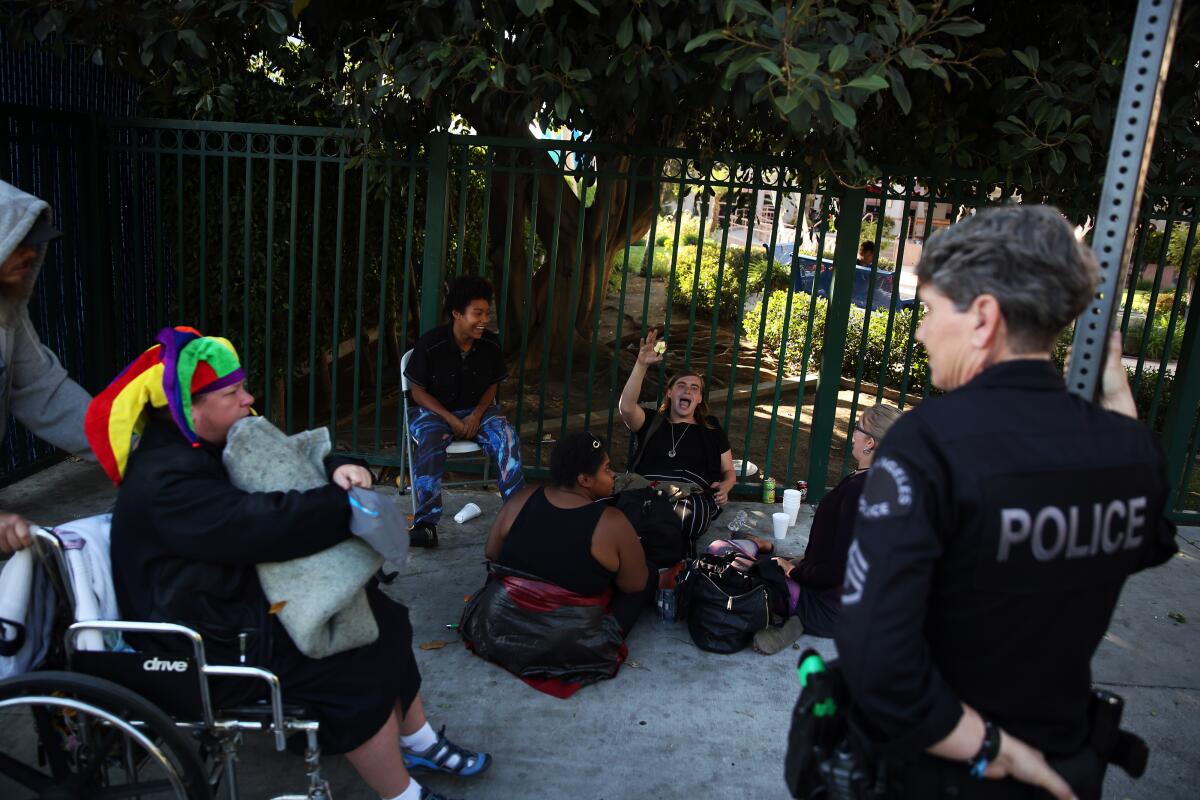Of course homeless encampments don’t make great neighbors. So let’s get people housed

- Share via
Living near homeless encampments can mean navigating sidewalks taken over by tents and strewn with trash or even human waste. It can mean enduring noise — the chatter, the arguments, the screaming — of people living on the streets outside your windows. It sometimes means there’s drug use nearby, even the threat of violence. That was the grim portrait of life for a neighborhood in Hollywood that Times columnist Steve Lopez painted in his recent columns in this paper.
You can’t read the columns without recognizing the obvious: that homelessness is bad for all of us. It’s clearly disastrous for those caught in its embrace, living on the streets or in shelters — troubled, destitute, fearful, vulnerable. But it’s also affecting the rest of the city, which is just another reason why efforts to solve it need to be redoubled.
In recent years, the homeless population in the city of Los Angeles has swelled to 36,000 people — 27,000 of them unsheltered on the streets — and a dearth of shelter beds and permanent housing have triggered face-offs between the housed and the unhoused in neighborhoods, fueling anger, frustration, sympathy, resentment and many other emotions among the city’s non-homeless residents.
As we have said in these pages many times before, the city needs to work harder and more effectively to address homelessness. In the short term, it needs reasonable rules that balance the rights of the homeless with the need to keep L.A. clean, safe and livable. There are plenty of hard choices to be made about where and when homeless people may sleep on the streets, when and if laws should be enforced against them, who should pay (and how much) for programs to house them.
But it seems undeniable that people who have homes and people who do not share a powerful interest in finding humane and durable solutions to this enormous human tragedy.
Angelenos who pay their rents and taxes did not create the homelessness situation with which we all must now cope. And homeless people are, by and large, homeless as a result of a variety of factors: a loss of a job, an eviction, an abusive marriage, a drug addiction, a mental illness, a lifetime of poverty, to name just a few. The overriding cause is a severe lack of affordable housing, fueled by years of escalating rents, and low turnover of housing.
We all know — or should, by now — that only more housing and shelter and treatment and services will reduce homelessness. But the pace of housing production has been infuriatingly slow. Three years after the city passed Proposition HHH, a $1.2-billion bond measure to subsidize housing for homeless people (along with some affordable housing for people on very low incomes), only one new housing development has opened. Several thousand units are scheduled to open over the next few years and, ultimately, about 8,500 units financed by the bond money should open.
The “bridge shelters” that the city is financing and putting up as interim housing are taking almost as much time to erect as permanent housing. And even if every unit of housing and shelter came online tomorrow, it wouldn’t house every homeless person on the streets. There are also “rapid rehousing” programs that use temporary housing or rental subsidies to help people who have just fallen into homelessness. But none of this, so far, has staved off the alarming rise in homelessness in the city (and the county) this year. Even though 21,631 people were permanently housed in L.A. County in 2018, the percentage of homeless people went up 12% in the county and 16% in the city.
City and county officials, who until several years ago only tinkered around the edges of the issue, need to treat it now with the urgency, creativity and political courage it demands. They need to increase both the amount of permanent housing — and they need more temporary bridge shelter beds where people can stay for weeks or months on their way to housing. Busing people to the Antelope Valley or erecting a mythical tent city near LAX won’t do it. But transforming existing empty or underutilized buildings into rooms or units of housing or shelter might.
And while the city cannot boot people off the sidewalks at night (under the terms of a court settlement) and cannot jail people simply for having a tent up (thanks to a federal court decision), there are still ways that city officials and police officers can make the sidewalks less of a war zone. There are rules that can be enforced on making the sidewalks passable. And we have said, repeatedly, that the city must install more public toilets and more trash receptacles near homeless encampments.
Angelenos are tired of this crisis and are eager to see some progress. We couldn’t agree more.
More to Read
A cure for the common opinion
Get thought-provoking perspectives with our weekly newsletter.
You may occasionally receive promotional content from the Los Angeles Times.






